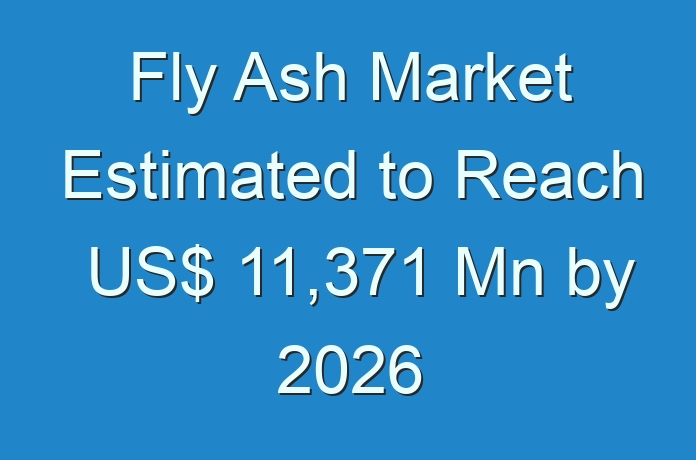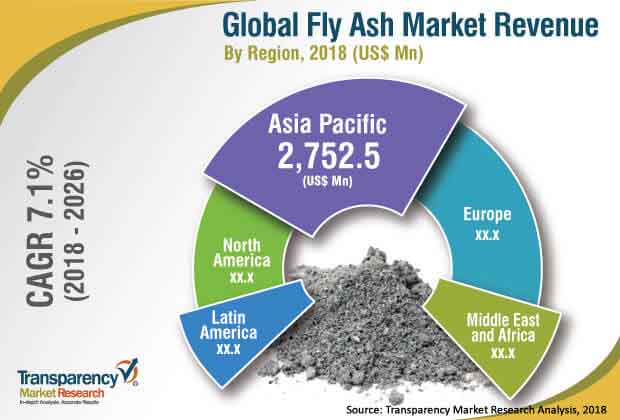
Fly Ash Market – Snapshot
Fly ash, also known as pulverized fuel ash, is a byproduct obtained from coal-fired electric power plants. Mineral impurities in coal (such as quartz, feldspar, clay, and shale) fuse in the suspension and float out of the combustion chamber as waste gases during the power generation process. These gases get solidified into orbicular particles upon cooling. These particles are known as fly ash. Fly ash is widely employed as a superior substitute for Portland cement in the construction industry. When added to concrete, fly ash improves strength, ease of pumping of concrete, and segregation. These advantages of fly ash over Portland cement make it a preferred material for construction activities. Cement and concrete used in construction activities is one of the major applications of fly ash. The fly ash market is expected to expand at a significant pace during the forecast period owing to the increase in construction activities in different regions and several initiatives taken by government authorities to promote the utilization of fly ash.

Request A Sample – https://www.transparencymarketresearch.com/sample/sample.php?flag=S&rep_id=51882
In terms of application, the cement & concrete segment is anticipated to expand significantly during the forecast period, due to the rise in the demand for sustainable construction materials and increase in construction output in developing countries. Fly ash typically replaces around 20% to 30% of the total Portland cement used in construction activities. The need for infrastructure has been increasing at significant pace since the last few years due to the rapid growth in global population. This has led to an increase in construction activities throughout the globe. Furthermore, developing countries such as China and India are experiencing substantial industrial, economic, and infrastructural development. Fly ash is extensively used in the construction industry as an environmentally-sustainable substitute for Portland cement. It is also employed to enhance the overall performance of ready-mix concrete. Furthermore, fly ash is used in the manufacture of bricks and blocks in the construction industry. It is also used in road construction. Fly ash is also employed in sectors such as mining, water treatment, and agriculture. Rise in demand for fly ash in these end-use industries is anticipated to fuel the global fly ash market. The structural fills segment is projected to expand at a rapid pace during the forecast period, led by the increase in usage of fly ash for highway embankment across the globe.
Fly ash is used widely in the construction industry in developed countries. However, lack of global awareness about the benefits of using fly ash as construction material is hampering the fly ash market. For instance, lack of awareness about potential uses of fly ash as construction material or as soil stabilizer in the agriculture sector is adversely affecting the global fly ash market. Increase in greenhouse gas (GHG) emissions across the world is a major factor responsible for global warming. Thermal power generation accounts for prominent share of the global carbon dioxide emissions. Regulatory bodies in developed regions such as Europe and North America are seeking renewable, environmentally sustainable alternatives for producing power as a measure to control CO2 emissions. This is estimated to negatively impact the overall production of fly ash. These factors are projected to restrain the fly ash market during the forecast period.
The fly ash market has been segmented based on type, application, and region. Based on type, the fly ash market has been bifurcated into class C and class F. In terms of revenue, the class F segment held major share of the fly ash market in 2017. Based on application, the fly ash market has been divided into cement & concrete, structural fills, mining waste stabilization, road constructions, and others. In terms of revenue and volume, the cement & concrete segment constituted significant share of the market in 2017, and is anticipated to expand at a rapid pace during the forecast period.
Based on region, the global fly ash market has been classified into Europe, North America, Asia Pacific, Middle East & Africa, and Latin America. Asia Pacific dominated the global fly ash market in 2017. This trend is estimated to continue during the forecast period. The region is projected to create lucrative opportunities for the fly ash market in the near future. China is likely to dominate the market in Asia Pacific, led by the increase in construction activities in the country. Furthermore, India contributes significantly to the fly ash market in Asia Pacific. Expansion in the fly ash market in Asia Pacific can also be ascribed to the high growth potential of the market in India, Japan, and ASEAN. The cement & concrete segment is a major consumer of fly ash in Asia Pacific.
The global fly ash market is fragmented. Large numbers of small and medium scale local suppliers of fly ash operate in the market. Key players functioning in the global fly ash market include Lafarge Holicim, Cemex S.A.B. De C.V., and Boral Ltd.
More Trending Reports by Transparency Market Research – https://www.prnewswire.com/news-releases/inks-market-to-reach-a-valuation-of-us-21-2-bn-by-2027-increasing-demand-from-packaging-industry-to-offer-lucrative-growth-opportunities-observes-tmr-300999345.html
Revival of Construction Activity Post Covid-19 to Leverage Engineering Value of Fly Ash
Fly ash is a useful constituent of byproduct of coal when fired in wide range of electric boilers or industrial boilers, and most commonly in cogeneration facilities. Millions of tons of fly ash has been extracted year-over-year. With this, studies that expand the understanding of the chemistries and features of fly ash remarkably, thereby constantly reshaping the contours of the fly ash market. The rise in demand for fly ash formulations in wide range of engineering applications particularly for highway constructions is a key trend in the market. The material forms part of Portland cement concrete (PCC), flowable fills, soil and road base stabilization, grouts, and structural fill and asphalt filler. A variety of PCC applications have utilized fly ash.
The Covid-19 pandemic has ravaged the macroeconomic of almost all nations around the world in a span of just few months. The lockdowns stalled various high-value construction projects in urban as well as in rural areas. This has had vast repercussions on the overall construction sector, and on the fly ash market. The shipments carrying fly ash has also suffered substantially in the early 2024. However, with economies opening up, new construction activities have picked up, resulting in the rise in demand in the fly ash market. In the first Q1 of 2024, the demand will pick up rapid pace especially coming from stalled residential projects in urban and rural centers.
Request For the Customization – https://www.transparencymarketresearch.com/sample/sample.php?flag=CR&rep_id=51882
The striking environmental benefits that fly ash endow is a key factor propelling the expansion of the fly ash market. Rise in number of concrete road making activities in developing economies in the last months fueled the expansion of the fly ash market. It has also emerged as an attractive material in application of displacing cement. Further, the demand for fly ash is one of the key aspects that make coal combustion more environmental friendly, since it reduces the burden of disposing of the byproduct in landfills.
Request for covid19 Impact Analysis – https://www.transparencymarketresearch.com/sample/sample.php?flag=covid19&rep_id=51882





